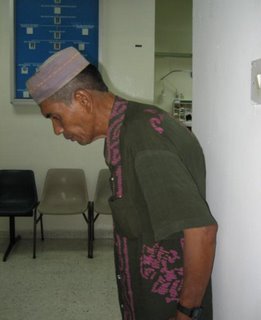Psoriasis With Axial Arthropathy

I had been quite busy for the past few weeks as I just joined skin department and there are a lot of new things to learn. It is a whole new world for me to explore.
As we all know, the prevalence of psoriasis is about 2% of the population. It is the bread & butter of dermatology practice. Here is one of the new cases that presented with difficulty in extending his neck for the past few years. We nearly miss this sign until he stood up to thank us after the consultation - he is unable to extend his neck to look at us. In addition, he needs to turn the whole body to look to either side.

As the picture shown, the occiput is not able to make contact with the wall when heel and the back are against the wall. It indicates upper thoracic and cervical limitation.
Questions:
1. What are the types of psoriatic arthropathy?
* Arthritis of DIP (Classical)
* RA like arthritis
* AS like arthritis (spondylitis and sacroiliitis)
* Mono- and asymmetrical oligoarthritis
* Arthritis mutilans
2. What is the most common psoriatic arthropathy?
* Mono- and asymmetrical oligoarthritis

As the picture shown, the occiput is not able to make contact with the wall when heel and the back are against the wall. It indicates upper thoracic and cervical limitation.
Questions:
1. What are the types of psoriatic arthropathy?
* Arthritis of DIP (Classical)
* RA like arthritis
* AS like arthritis (spondylitis and sacroiliitis)
* Mono- and asymmetrical oligoarthritis
* Arthritis mutilans
2. What is the most common psoriatic arthropathy?
* Mono- and asymmetrical oligoarthritis
Labels: Rheumatology, Station 5








1 Comments:
well done david
Post a Comment
<< Home